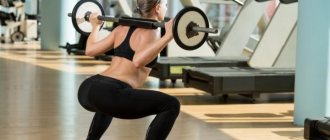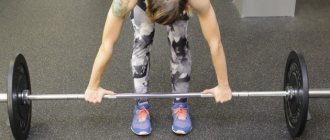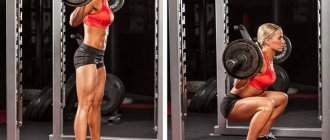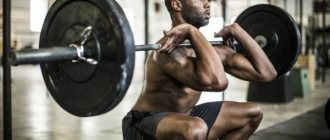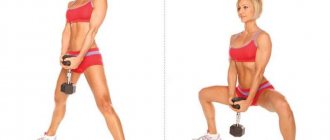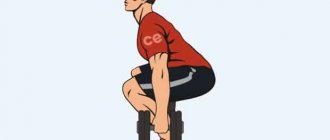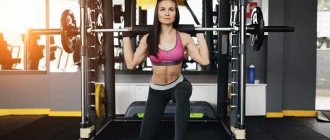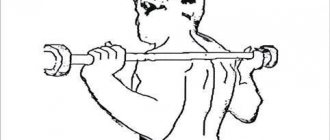Share:
What you need
- Barbell
Squats with a barbell on your shoulders are a basic exercise common in CrossFit and powerlifting, involving a huge number of muscle groups. Along with the deadlift and bench press, it is a kind of indicator of the athlete's functional and strength training, and the correct technique for performing this exercise is critically important. Today we will tell you how to do a barbell squat correctly, how to increase your results and what you can replace this exercise with.
The barbell squat is an integral tool for developing muscle mass in the legs and buttocks; there is hardly a single athlete in the world who does not do squats, and at the same time boasts powerful quadriceps. For this reason, this exercise has gained immense popularity in every gym in the world, and making progress in the squat is a significant goal for many experienced and not so experienced athletes.
Today we will tell you about how to do squats with a barbell correctly - the technique of the exercise, as well as what muscles work, all the pros, cons and contraindications to heavy squats. And a lot of other useful information.
Why is this exercise needed?
Legs are our foundation, no matter what sport we play. Boxing, wrestling, crossfit, powerlifting, fitness - you will not achieve significant success in any of these disciplines if your legs do not receive sufficient load as part of your training process.
The barbell squat is perhaps the heaviest exercise of all. And not only physically, but also mentally. Watch any powerlifting competition and notice how the lifters prepare themselves before their squat attempts. It is unlikely that you will want to get in the way of this person. Only in a state of crazy courage can you conquer such inhuman weights.
We’ve sorted out powerlifting, where the squat is a competitive movement. What is the role of squats in CrossFit:
- Squats with a barbell on the shoulders are part of many complexes for athletes of different levels of training.
- Without a technically correct squat, you can forget about movements such as the snatch, clean and jerk, thrusters, cleans, etc.
- The squat is one of those exercises that ramps up the intensity and pace of your workout. Performing really heavy squats requires enormous energy expenditure, emotional state and motivation, significantly increasing the heart rate, which contributes to the process of lipolysis.
Work of muscles and joints
As mentioned above, front squats load the upper thigh, that is, the quadriceps muscle. In addition to the target muscle group, the stabilizer muscles, of which there are a lot in this exercise, also receive load: calves, abdominal muscles, long back muscles, shoulders and even arms. In general, if you want to pump up your abs , then this exercise is not the worst option for this.
During squats with a barbell on the chest, the knee joint still receives quite a bit of load, since the spine is almost completely unloaded. Because of this, even a decrease in the absolute value of the load, due to the lower weight of the barbell, does not allow us to say that the knee joint is under less tension than during classic squats with a barbell, but the spine can actually be unloaded.
What muscles work?
The main dynamic load falls on:
- Quadriceps;
- Biceps femoris;
- Adductor muscles of the thigh;
- Gluteal muscles;
- Spinal extensors.
The abdominal muscles, gastrocnemius, soleus and trapezius muscles act as stabilizer muscles throughout the movement.
Impact on the lower back and knees
The technique of performing squats with a barbell on the chest is quite comfortable for the lower back and spine.
But when it comes to knee safety, the situation is ambiguous.
For example, in weightlifting, the exercise is specifically performed by bringing the knees forward as much as possible and trying to keep the back in an upright position. This is exactly the technique used when pushing.
Naturally, a large traumatic load falls on the knees. But in big sports, risking your own health is a necessary condition for a high result.
Probably, it was from weightlifting that word spread about the increased risk of injury to the knees of front squats.
In bodybuilding the situation is different:
- Here, a high-repetition load mode is adopted (10-20 times per approach), rather than a power load (5-1 times)
This means much less weight on the bar, which means less stress on your knees.
- As a rule, they do not perform a full squat, but a half squat, which also reduces the load on the joints
- Increased attention to knee position
Make sure that your knees do not go beyond your toes. As a result, the load is even less than in squats with a barbell on the shoulders.
Pros and cons of barbell squats
The barbell squat is a basic compound exercise that works almost every major muscle group in your body. It is unlikely that any exercise other than the deadlift can compare with squats in this regard. This kind of load cannot but lead to results: you become stronger, more resilient and more muscular.
Benefits of exercise
For men, heavy squats are the #1 exercise. Numerous studies prove the hypothesis that performing this exercise leads to increased secretion of the main anabolic hormone - testosterone. It is this hormone that is responsible for all the traits inherent in a real man: physical strength and endurance, self-confidence, consistently high sexual energy, cheerful well-being, as well as what is commonly called “male charisma.” For this reason, we recommend that all men, regardless of age, perform barbell squats, unless there are medical contraindications.
Start with small working weights and gradually add discs to the barbell, then over time you will see that you have not only made serious progress in your workouts in the gym, but also generally feel more confident and energetic.
However, all this does not mean that squats are a purely masculine exercise. For girls, barbell squats should also become one of the foundations of the training process. It is this movement that puts the most stress on the hips and glutes and gives them an athletic shape.
In addition, intensive squats involve a fairly serious expenditure of energy. A few really hard sets will burn more calories than walking on a treadmill for half an hour. Therefore, squats should be performed not only if your goal is to slightly pump up your legs and buttocks, but also during the period of getting rid of excess fat, so the drying process will be much more efficient.
Possible harm from exercise
All potential harm from barbell squats comes down to the consequences caused by poor technique. A strong deviation from the correct technique or working with critically heavy weights can lead to injuries to the knee ligaments and joints, as well as the occurrence of protrusions and hernias in the lumbar spine. Injuries to the shoulder joints and rotator cuff are also not uncommon. As a rule, they arise as a result of incorrect (too low) position of the barbell.
It is also believed that barbell squats lead to one unpleasant side effect - an increase in waist size. This is not entirely true, because your waist size is determined by genetics, the tendency of the obliques to hypertrophy, and the volume of your stomach. However, the load on the obliques and abs during squats is really serious, and if you value your waist and feel that it is starting to grow, then it is better to slow down with heavy weights in squats and deadlifts. Squats also increase intra-abdominal pressure, which can lead to the formation of an umbilical hernia, but in most cases this problem can be avoided by using an athletic belt.
Contraindications
During squats with a barbell, a strong axial load is created on the spine, so this exercise is strictly contraindicated for all athletes who have any problems with the musculoskeletal system. The same goes for knee or hip joints: if you have had injuries in the recent past, then performing barbell squats should be kept to a minimum. For rehabilitation and restoration of injured tissues, it is better to use isolated exercises, for example, bending and extending the legs in a machine.
Classic barbell squat technique
Let's first look at the basic technique of performing squats with a barbell for men and women, and then add separate recommendations for each of the variations of the exercise.
Be sure to warm up your entire body thoroughly with a set of cardio exercises. Do several sets of empty bar squats.
Basic technique
The optimal height of the barbell is the level of the athlete’s collarbones.
- Stand under the bar, squat slightly, bending at the waist (without rounding your back), place the barbell on the trapezius, and remove it from the racks. Take a couple of steps back so as not to touch the frame during squats;
- The starting position for most types of barbell squats for men and women is the same: feet shoulder-width apart, hands on the bar, elbows back, back straight, shoulder blades pulled together, abs tense, gaze forward.
- Don't forget about proper breathing when squats. As you inhale, begin to slowly lower yourself until your thighs are parallel to the floor. The pelvis is pulled back and the knees are separated. At the same time, the back bends, due to which the body leans slightly forward. It is important to distinguish between natural leaning and excessive leaning.
- As you exhale, slowly rise up, returning to the starting position.
Please note that the depth of the squat affects the difficulty of the exercise. If you squat below parallel, your buttocks and back will be more stressed. However, we recommend that beginners start practicing from the golden mean, which is the lowest point at which the lower leg and thigh form a right angle.
Variations
So, we have figured out how to do classic squats with a barbell, now let's move on to other variations. By the way, the basic principles of the technique remain similar, but there are nuances.
- Barbell squats with narrow leg stance. Due to it, the quadriceps, as well as the outer surface of the thigh, are more actively involved. This variation will not allow you to work at full amplitude, so the maximum depth of the squat will be parallel. There are no differences in technology.
- Squats with a barbell with wide legs. The most commonly practiced exercise in this category is sumo squats. The direction of the load on specific muscles depends on the correct positioning of the legs when squatting with a barbell. In this case, the muscles of the inner thigh, as well as the gluteal muscles, work stronger. The main nuance of the technique is that the socks need to be turned out as wide as the stretch allows you. They should look strictly in the same direction as their knees.
- Front squats. It is impossible to work with super-heavy weights with them, so this subtype is not intended for records. The technique of performing a squat with a barbell on the sternum only at first glance seems different from the algorithm in the classic version. This is because the bar is in front. However, in essence, this is the only difference. Oh, yes - the body tilt here is less deep, otherwise the athlete will simply fall forward. If you are wondering what muscles are involved in front squats with a barbell, we will emphasize that the muscles of the front of the thigh receive the greatest load.
- Squats with a barbell on a Smith machine. This is a special frame in which the bar is fixed and can only move up and down. The main advantage of this simulator is that the athlete does not need to control balance or monitor the amplitude of the tilt. Therefore he feels more secure and comfortable. We recommend that beginners squat in Smith. The technique, by the way, remains similar to the algorithm for working in a conventional frame. Unless you remove the bar with a rotational motion. The Smith machine can be used to do any type of barbell squat: front, classic, wide or narrow.
Common mistakes
The correct barbell squat technique for men and women does not accept the following mistakes:
- Rounding of the back;
- Lifting the heels off the floor, and thereby transferring the weight to the toes;
- The knees go beyond the line of the socks;
- The knees are brought together;
- Toes and knees point in different directions (not parallel);
- Lifting by pushing your tailbone up, and not by using the strength of your leg muscles alone;
- Breathing irregularly, holding your breath, rising while inhaling;
- Working on cold muscles or feeling unwell;
- Extreme weight or working without a supporter.
99% of all these mistakes lead to injury!
So, we have looked at the basic technique of performing squats with a barbell on the shoulders or chest for men and women. Now the time has come to move from theory to practice. Below is a sample workout diagram for beginners.
Execution technique
There are many hypotheses regarding the correct technique for squats with a barbell on the shoulders. Their number is due to the fact that the technique can vary due to the anatomical characteristics of a particular person (for example, the length of the limbs, the volume of the buttocks, flexibility in the hip and shoulder joints, etc.). Therefore, the recommendations listed below are of a general nature only; a competent personal trainer can help you develop a more acceptable technique. Well, let's figure out how to do a barbell squat correctly.
Taking the barbell on your back
The first phase of the movement is to remove the barbell from the racks. Grasping the bar tightly at a width slightly wider than your shoulders, we sit under the bar exactly in the center of the bar, pressing into the bar with our trapezoids, and remove the bar with the movement of our legs. It is extremely important to keep your back straight when removing the bar from the racks, since it is at this moment that our spine experiences maximum axial load.
The next phase is to move away from the posts and secure yourself. You need to take a few steps backwards, find a stable, stable position and begin the exercise. Take your time when you step backwards; your movements should be smooth and confident. Otherwise, you will lose balance and control of movement, thereby risking injury.
Squat
Front squats - diagram
1) Sit under the barbell, placing it on the front deltoid and holding it with your hands. 2) Stand with the barbell, arching your back and raising your head up. 3) Turning your toes forward so that they are parallel to each other, shift the center of gravity to the heel. 4) Sit down slowly, placing your center of gravity through your heels so that your knees do not go beyond the line of your toes. 5) Without staying too long at the bottom point, with a powerful push return the body to its original position, leaving the knees slightly bent.
Front Squats - Notes
1) It is very important not to round your back or lean forward while doing squats. 2) The center of gravity should not be shifted to the toe, as this will lead to loss of balance. 3) The legs must be placed quite wide, since otherwise it will be simply impossible to anatomically perform squats with a barbell on the chest. 4) The knees should not be spread or contracted; their range of motion should be constant throughout the exercise. 5) The barbell should not be pressed against your neck, as this will interfere with your breathing, and breathing should not be interrupted in any exercise.
How to increase your barbell squat?
Every second gym goer wonders how to increase a barbell squat. There are many methods, but the point is always in two aspects: proper cycling of loads (using percentages and alternating light/heavy training) and performing auxiliary exercises. In practice, a competitive powerlifter will typically do two squat workouts per week, one with a weight equal to 50-60% of the maximum for 5 reps for three sets, and the other with a weight equal to 75-85% of the maximum. maximum, 5 repetitions in five approaches. Closer to the competition, the weight of the bar increases, and the number of repetitions decreases.
When it comes to accessory exercises, the most commonly preferred exercises are pause squats, front squats, barbell bend-overs, bench squats, and overhead squats.
- Pause squats are a type of squat in which the athlete works at the deepest possible amplitude, fixating for a few seconds at the lowest point. The upward movement is explosive in nature, thereby significantly increasing the speed of the lift during normal squats.
- Front squats differ from classic squats with a barbell in the position of the bar - here it is on the chest. Thanks to this, the vector of movement changes slightly, and the quadriceps receives a more serious load.
- Bent-overs are extremely important for strength athletes because they help keep your core more stable during heavy squats.
- Bench squats are a type of squats with a shorter amplitude (we lower ourselves above parallel), where our task is to lower ourselves to the level of the bench.
- Overhead squats are a coordination exercise that are quite challenging for beginners. Helps you get a better feel for corners and blind spots.
Anatomy
Front squats specifically target one of the largest muscles in the human body - the quadriceps femoris muscle, which, as the name suggests, consists of as many as four heads, respectively, and there is a need to train this muscle with volume and intense training if you want to pump up legs . In addition, since there are many heads, their participation in the force differs depending on the position of the legs, so the quadriceps must be pumped differently.
Squats with a barbell, like all squats, heavily load the knee joint, which must be taken into account, since in this case it takes almost the entire load on itself. As a result, there is no need to chase weight; it should be remembered that this is not a strength exercise, but an exercise that develops hypertrophy of the anterior thigh, and, like any formative exercise, it does not involve a small number of repetitions and “cheating”.
Other exercises
Common mistakes
If doing squats doesn't give you the results you want, you're doing something wrong. Below is a short list of the most common mistakes that are common to most novice athletes:
Incorrect range of motion
Only deep squats give a truly serious effect. If you don't even go down to parallel level with the floor, then don't expect results. At the lowest point, the back of the thigh should touch the calf muscles. Not all athletes succeed in this immediately due to weak stretching, so do not forget to stretch after training, special attention should be paid to the quadriceps and adductor muscles of the thigh.
Rounding the back while lifting
This can be seen in every gym when an athlete squats with maximum weight. If your back is not strong enough to stay straight during heavy squats, then you should lower the weight a little and start training your spinal extensors. Hyperextensions with additional weights are best suited for this. Using an athletic belt also partially solves this problem.
Movement in the lumbosacral spine
You may have seen more than once how some athletes “peck” their tailbone at the lowest point of the amplitude. This makes lifting a little easier, but under no circumstances should you do this - this is a direct path to injury.
Movement in the knee joint
Throughout the entire exercise, your knees should be in the same plane as your feet. Movement of the knees inward relative to the proper trajectory is unacceptable. A meniscus injury can put an end to your sports career.
Incorrect foot position
The feet should be slightly turned out and slightly wider than shoulder level. This is the only way you can sit deep enough without creating a strong load on the knee joint.
Incorrect breathing technique
Remember one simple rule: exhalation is always done with effort. Therefore, you need to inhale while going down, exhale while going up. If you do not follow this technique, your muscles will not receive enough oxygen and the effectiveness of the exercise will be greatly reduced. Deterioration in health, headache, nausea and fainting are also possible as a result of insufficient cerebral blood supply and increased intracranial pressure.
Technique for performing squats with a barbell on the shoulders
Several rules must be followed in order for the exercise to bring the desired result.
Positioning the legs. The position of the legs should correspond to the width of the shoulders, the toes point forward, you can spread them a little. This starting position can be called classic. When starting to master barbell squats, this option will be the main one. In the future you can experiment. If at the moment of squatting you lift your heels off the floor, you can add pancakes. But this does not bring any benefit. Imagine walking with special supports on your heels.
Grab. Usually a closed grip of the bar is used (position b in the figure). The distance between your hands on the bar doesn't really matter. It is necessary to take into account that they must be located symmetrically from the center. This is necessary so that you do not lose your balance while squatting.
Barbell squat grip
Neck and eye position. When squatting with a barbell, you need to look slightly above the horizon. This allows you to maintain the correct position of your neck and keep it straight. If you lower your eyes, your neck will automatically bend. When performing an exercise with such a posture, there is a risk of developing osteochondrosis or injuring the spine. Remember not to look at the floor when squatting.
Neck and eye position
Neck position. You can hold the barbell on your shoulders, shoulder blades, or front deltoid. There is no universal rule here, and everyone chooses something different, usually this is the golden mean - on the shoulders. When positioned on the shoulders, the entire load will be distributed between the back and legs. Such loads are used in fitness and bodybuilding.
Neck position
Starting position and downward movement.
Place your feet shoulder-width apart with your toes pointed slightly outward. To remove the bar from the rack, use a closed bar grip and place the bar on your neck in the rear deltoid area, then take one step back from the rack. When squatting, keep your back straight with a slight tilt forward, this will reduce the load on the spine.
When squatting, keep your back straight with a slight lean forward
You need to look straight ahead. During squats, the buttocks will protrude back, and the knees should not protrude further than the feet. It is necessary that the main load is borne by the leg muscles and the movements are smooth. When performed correctly, the exercise will engage the back and front muscles of the thigh, buttocks and lower back.
Squat depth. You can perform the exercise until it is parallel to the floor or go lower. Many are of the opinion that parallel squats reduce the load on the knee joint. This effect will only occur if you squat freely - uncontrollably, and if not, then the load will be quite large. By squatting deeply, the muscles of the buttocks and thighs will participate in the exercise, and with this version of squats, the effectiveness of the exercise increases.
Squat technique and depth
Upward movement. Begin to rise up, pushing your heels off the floor. Straightening your legs, return to the starting position. Repeat for the set number of repetitions.
Upward movement
When moving the barbell up and down, you need to monitor your breathing. When moving down, inhale, and when moving up, exhale. You need to sit down smoothly and not spring back, and rise as well. In the upper position, you need to leave your legs slightly bent and fix this moment. The number of repetitions of the exercise depends on your training and the weight of the barbell used.
Standards for squatting without equipment
Unfortunately, the federal budget of our country is not enough to promote the development of powerlifting, so we have only one federation officially accredited by the State Sports Committee of the Russian Federation - the Russian Powerlifting Federation (RFP).
The standard is assigned based on the sum of three movements (squats, bench press, deadlift). There is no separate test for squats. If you want to truly test your strength, I highly recommend taking part in competitions. Competitions are regularly held throughout the Russian Federation; the competition calendar and regulations can be found on the official website of the federation.
There are also more than ten non-state federations operating on a commercial basis. The main funding comes from private investors, advertising of thematic products (sports nutrition, clothing and equipment) and entry fees from competition participants. The most popular non-state federation is WPC/AWPC (without doping control/with doping control). Below are their raw powerlifting standards for 2021.
AWPC-Russia category standards for bare powerlifting for men:
| Weight category | Elite | MSMK | MS | KMS | I category | II category | III category | I junior | II junior |
| 52 | 490 | 432.5 | 377.5 | 340 | 302.5 | 265 | 227.5 | 187.5 | 150 |
| 56 | 532.5 | 470 | 410 | 367.5 | 327.5 | 287.5 | 245 | 205 | 162,5 |
| 60 | 570 | 505 | 440 | 395 | 350 | 307.5 | 262.5 | 220 | 175 |
| 67,5 | 635 | 562.5 | 490 | 440 | 392.5 | 342.5 | 292.5 | 245 | 195 |
| 75 | 692.5 | 612.5 | 532.5 | 480 | 425 | 372.5 | 320 | 265 | 212,5 |
| 82,5 | 737.5 | 652.5 | 567.5 | 510 | 455 | 397.5 | 340 | 285 | 227,5 |
| 90 | 777.5 | 687.5 | 597.5 | 537.5 | 477.5 | 417.5 | 357.5 | 297.5 | 240 |
| 100 | 817.5 | 725 | 630 | 567.5 | 502.5 | 440 | 377.5 | 315 | 252.5 |
| 110 | 852.5 | 752.5 | 655 | 590 | 525 | 457.5 | 392.5 | 327.5 | 262.5 |
| 125 | 890 | 787.5 | 685 | 617.5 | 547.5 | 480 | 410 | 342.5 | 275 |
| 140 | 920 | 812.5 | 707.5 | 635 | 565 | 495 | 425 | 352.5 | 282.5 |
| 140+ | 940 | 832.5 | 725 | 652.5 | 580 | 507.5 | 435 | 362.5 | 290 |
For women:
| Weight category | Elite | MSMK | MS | KMS | I category | II category | III category | I junior | II junior |
| 44 | 287.5 | 255 | 222.5 | 200 | 177.5 | 155 | 132.5 | 110 | 90 |
| 48 | 317.5 | 282.5 | 245 | 220 | 195 | 172.5 | 147.5 | 122.5 | 97,5 |
| 52 | 345 | 305 | 265 | 240 | 212.5 | 185 | 160 | 132.5 | 107,5 |
| 56 | 372.5 | 327.5 | 285 | 257.5 | 227.5 | 200 | 172.5 | 142.5 | 115 |
| 60 | 395 | 350 | 302.5 | 272.5 | 242.5 | 212.5 | 182.5 | 152.5 | 122.5 |
| 67,5 | 432.5 | 382.5 | 332.5 | 300 | 265 | 232.5 | 200 | 165 | 132.5 |
| 75 | 462.5 | 410 | 355 | 320 | 285 | 250 | 212.5 | 177.5 | 142.5 |
| 82,5 | 487.5 | 432.5 | 375 | 337.5 | 300 | 262.5 | 225 | 187.5 | 150 |
| 90 | 507.5 | 450 | 390 | 352.5 | 312.5 | 272.5 | 235 | 195 | 157,5 |
| 90+ | 520 | 460 | 400 | 360 | 320 | 280 | 240 | 200 | 160 |
